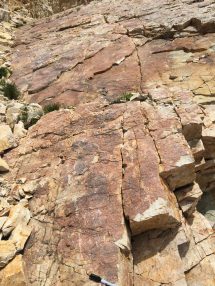
Opening-mode fractures
Natural fractures, the more or less planar discontinuities in rock, include faults and opening-mode fractures, based on displacement direction relative to the orientation of the fracture walls.
A considerable part of SDI research focuses on opening-mode fractures. These are particularly challenging for reservoir simulation because they are difficult to sample and commonly below detection limits for geophysical methods.
Opening-mode fractures are traditionally subdivided, based on the presence or absence of mineral deposits within them, into veins or joints (or extension fractures), respectively, but this terminology is not helpful for describing fractures in the subsurface.
For example, in tight gas sandstone cores, fractures of the same set may be classifiable as fully cement-filled veins in one location or bed, and in adjacent locations or beds as apparently barren (albeit usually cement lined) joints (Laubach, 2003). Moreover, owing to size dependence of degree of cement fill (e.g., Lander and Laubach, 2015), small fractures (microfractures) of a given set typically qualify as veins, whereas larger fractures may fit the definition of joints.
Consequently, the conventional terms vein and joint are not helpful in typical reservoir settings where fractures can have a spectrum of cement-fill attributes. We use the unambiguous descriptive term opening-mode fracture and specify the cement attributes.
Lander R.H., and Laubach, S.E., 2015. Insights into rates of fracture growth and sealing from a model for quartz cementation in fractured sandstones. Geological Society of America Bulletin, 127 (3-4), 516-538. doi: 10.1130/B31092.1 | view
Laubach, S. E., Olson, J. E, and Gross, M. R., 2009. Mechanical and fracture stratigraphy. AAPG Bulletin, 93(11), 1413-1426. doi: 10.1306/07270909094 | view
Laubach, S. E., 2003. Practical approaches to identifying sealed and open fractures, AAPG Bulletin, 87(4), 561-579. doi: 10.1306/11060201106 | view
© 2024 Jackson School of Geosciences, The University of Texas at Austin


